|
|
 |
|
Calanoida ( Order ) |
|
|
|
Clausocalanoidea ( Superfamily ) |
|
|
|
Clausocalanidae ( Family ) |
|
|
|
Clausocalanus ( Genus ) |
|
|
| |
Clausocalanus minor Sewell, 1929 (F,M) | |
| | | | | | | Syn.: | Clausocalanus arcuicornis minor : Sewell, 1929 (p.92, figs.F); Tanaka, 1956 c (part., p.382, fig.11c: F); Brodsky, 1962 c (part., p.116, figs.F); Furuhashi, 1966 a (p.295, vertical distribution in Kuroshio region, Table 10); Neto & Paiva, 1966 (p.22, Rem.);
C. arcuicornis : Früchtl, 1924 b (p.20, fig.9); ? Krishnaswamy, 1953 (p.116); Farran, 1936 a (part., p.82, fig.2b); Dakin & Colefax, 1940; Tanaka, 1960 (part., p.30, pl. X, figs.7, 8); Brodsky, 1962 c (part., p.116, pl.20); ? Saraswathy, 1966 (1967) (p.76);
C. arcuicornis sp.4 : Fleminger, 1964 a; 1967 a (tab.I) | | | | Ref.: | | | Frost & Fleminger, 1968 (p.59, figs.F,M, Rem.); Chen Zhang, 1974 (p.103); Greenwood, 1977 (p.52, figs.F); Bradford-Grieve, 1994 (p.119, figs.F,M, fig.101); Chihara & Murano, 1997 (p.777, Pl.89,94: F,M); Bradford-Grieve & al., 1999 (p.878, 916, figs.F,M); Bucklin & al., 2003 (p.335, tab.2, fig.1, Biomol); Al-Yamani & Prusova, 2003 (p.45, figs.F,M); Al-Yamani & al., 2011 (p.34, figs.F,M) | 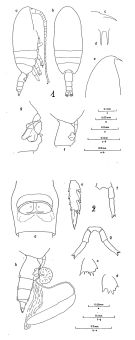 issued from : B. Frost & A. Fleminger in Bull. Scripps Inst. Oceanogr. Univ. California, San Diego, 1968, 12. [Pl.43, p.186-187; Pl.44, p.188-189]. Female: 1 a, habitus (right lateral view); 1 b, idem (dorsal view); 1 c, rostrum (right lateral); 1 d, rostrum (anteroventral); 1 e, frontal region (right lateral); 1 f, Th.4-5 (posterior part) and genital segment (right lateral); 1 g, ventral half of genital segment (right lateral); a,b,g taken from one specimen; c,e from another; d,f from third and fourth specimens, respectively; 2 a, genital segment (ventral view); 2 b, Th.4-5 (posterior part) and urosome with spermatophore attached (right lateral); 2 c, B2 of P2; 2 d, B2 of P3; 2 e, Re3 and St of P3; 2 f-g, P5; 2a-b from different specimens; 2 c-e from a third; 2 f and 2 g from fourth and fith, respectively. Nota: In lateral view ventral profile of genital segment with a prominent step posterior to genital pores
|
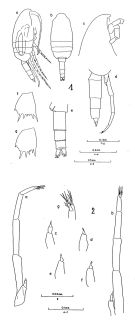 issued from : B. Frost & A. Fleminger in Bull. Scripps Inst. Oceanogr. Univ. California, San Diego, 1968, 12. [Pl.45, p.190-191; Pl.46, p.192-193]. Male: 1 a, habitus (right lateral view); 1 b, idem (dorsal view); 1 c, frontal region (right lateral); 1 d, Th.4-5 (posterior part) and urosome (right lateral); 1 e, urosome (dorsal); 1 f, B2 of P2; 1 g, B2 of P3; 1 a-d all from different specimens; 1 e-g taken from one specimen; 2 a, P5 (right lateral); 2 b, P5 (posterior); 2 c-f, right P5; 4 P5 (distal part) and 5 P5 (left posterolateral); 2 a-g taken from different specimens. Nota: Right P5 bi - or trimerous, distal segments large. A1 fused segments 20-21 more than 1.35 times as long as segment 22. Nota: Right P5 always biremous, distal segment reduced. A1 fused segments 20-21 less than 1.35 times as long as segment 22.
|
 issued from : R.B.S. Sewell in Mem. Indian Mus., 1929, X. [p.92, Fig.36]. As Clausocalanus arcuicornis forma minor. Female (from Nankauri Harbour ): a, habitus (lateral right side); b, urosome (ventral); c, genital segment; d, P2; e, P3; f, P4; g, P5; g', the end of distal segment of P5 (enlarged).
|
 issued from : B. Frost & A. Fleminger in Bull. Scripps Inst. Oceanogr. Univ. California, 1968, 12. [p.46, Table 3a]. Clausocalanus minor Females: Measurements and ratios . TL = total body length ; SL = spermatophore length ; P :U = ratio of prosome length to urosome length ; U :U1 = ratio of total urosome length to length of 1st urosomal segment (genital segment) ; S :U1 = ratio of spermatophore sac length to U1 length of female on which spermatophore is attached ; r = sample range; m = sample mean; n = number of specimens measured; s = sample standard deviation.
|
 issued from : B. Frost & A. Fleminger in Bull. Scripps Inst. Oceanogr. Univ. California, 1968, 12. [p.47, Table 3b]. Clausocalanus minor Males: Measurements and ratios . TL = total body length; P :U = ratio of prosome length to urosome length ; P:U2 = ratio of prosome length to length od 2nd urosomal segment; U2:2P5 = ratio of U2 length to length of 2nd segment of longer ramus of P5; U2:3P5 = ratio of U2 length of 3rd segment of longer ramus of P5; 3P5:2P5 = ratio of length of 3P5 of longer ramus to length of 2P5 of longer ramus; r = sample range; m = sample mean; n = number of specimens measured; s = sample standard deviation.
|
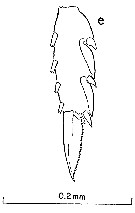 issued from : B. Frost & A. Fleminger in Bull. Scripps Inst. Oceanogr. Univ. California, 1968, 12. [p.189, Pl.44, e]. Female: e, exopodal segment 3 of P3.
|
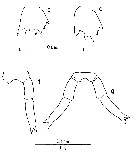 issued from : B. Frost & A. Fleminger in Bull. Scripps Inst. Oceanogr. Univ. California, 1968, 12. [p.189, Pl.44, c, d, f-g]. Female: c, basipodite 2 of P2; d, basipodite 2 of P3; f-g, P5 (from different specimens).
|
 issued from : B. Frost & A. Fleminger in Bull. Scripps Inst. Oceanogr. Univ. California, 1968, 12. [p.191, Pl.45, d, e]. Male: d, posterior part of last thoracic segment and urosome (right lateral); e, urosome (dorsal).
|
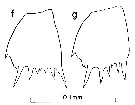 issued from : B. Frost & A. Fleminger in Bull. Scripps Inst. Oceanogr. Univ. California, 1968, 12. [p.191, Pl.45, f, g]. Male: f, basipodite 2 of P2; g, basipodite 2 of P3.
|
 issued from : B. Frost & A. Fleminger in Bull. Scripps Inst. Oceanogr. Univ. California, 1968, 12. [p.193, Pl.46]. Male: a, P5 (right lateral); b, P5 (posterior); c-f, right P5 (lateral); g, 4th segment of P5 (distal part) and 5th segment of P5 (posterolateral). from different specimens.
|
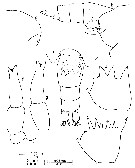 issued from : J.G. Greenwood in Proc. R. Soc. Qd, 1977, 88. [p.53, Fig.1]. Female (from 27°20'S, 153°15'E): a, forehead (lateral); b, 5th thoracic segment and urosome (lateral); c, same (ventral); d, basis of P3; e, basis of P2; f-g, P5.
|
 issued from : Y. Al-Yamani, V. Skryabin, A. Gubanova, S. khvorov & I. Prusova in Marine Zooplankton Practical Guide for the Northwestern Arabian Gulf, 2, 2011. [p.34, Fig.150]. Female (from Kuwait): A-B, habitus (dorsal and lateral, respectively); C, urosome (dorsal); D, rostrum; E, genital segment (left lateral); F, P5.
|
 issued from : Y. Al-Yamani, V. Skryabin, A. Gubanova, S. khvorov & I. Prusova in Marine Zooplankton Practical Guide for the Northwestern Arabian Gulf, 2, 2011. [p.35, Fig.152, a-c]. Female: a-b, habitus (dorsal and left lateral, respectively); c, urosome (left lateral).
|
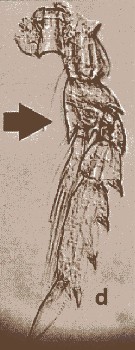 issued from : Y. Al-Yamani, V. Skryabin, A. Gubanova, S. khvorov & I. Prusova in Marine Zooplankton Practical Guide for the Northwestern Arabian Gulf, 2, 2011. [p.35, Fig.152, d]. Female: P3 (arrow indicates characteristic of the basipodite).
|
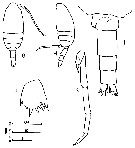 issued from : Y. Al-Yamani, V. Skryabin, A. Gubanova, S. khvorov & I. Prusova in Marine Zooplankton Practical Guide for the Northwestern Arabian Gulf, 2, 2011. [p.34, Fig.151]. Male: G-H, habitus (dorsal and left lateral, respectively); I, urosome (dorsal); J, basipodite of P3; K, P5.
|
 issued from : Y. Al-Yamani, V. Skryabin, A. Gubanova, S. khvorov & I. Prusova in Marine Zooplankton Practical Guide for the Northwestern Arabian Gulf, 2, 2011. [p.35, Fig.153] Male: a-b, habitus (dorsal and left lateral views, respectively).
| | | | | Compl. Ref.: | | | Fleminger, 1967 a (tabl.1); Fleminger & Hulsemann, 1973 (p.340, carte); Carter, 1977 (1978) (p.35); Smith S.L., 1982 (p.1331, abundance, monsoon effect); Van der Spoel & Heyman, 1983 (p.44, fig.55); Madhupratap & Haridas, 1986 (p.105, tab.1); Othman & al., 1990 (p.561, 563, Table 1); Shih & Young, 1995 (p.72); Hsiao & al., 2004 (p.325, tab.1); Hsieh & al. 2004 (p.397, tab.1, p.399, tab.2); Lan & al., 2004 (p.332, tab.1, tab.2); Lo & al., 2004 (p.89, tab.1); Kazmi, 2004 (p.229); Cornils & al., 2007 (p.58, 60, 66,Rem.); Dur & al., 2007 (p.197, Table IV); Lan Y.C. & al., 2008 (p.61, Table 1, % vs stations); C.-Y. Lee & al., 2009 (p.151, Tab.2); Lan Y.-C. & al., 2009 (p.1, Table 2, % vs hydrogaphic conditions); Cornils & al., 2010 (p.2076, Table 3); Fazeli & al., 2010 (p.153, Table 1); Hsiao S.H. & al., 2011 (p.475, Appendix I); Hsiao & al., 2011 (p.317, Table 2, indicator of seasonal change); Uysal & Shmeleva, 2012 (p.909, Table I); Johan & al., 2012 (2013) (p.1, Table 1); in CalCOFI regional list (MDO, Nov. 2013; M. Ohman, comm. pers.); Tachibana & al., 2013 (p.545, Table 1, seasonal change 2006-2008); Hirai & al., 2013 (p.1, Table I, molecular marker); Ohtsuka & Nishida, 2017 (p.565, Table 22.1); | | | | NZ: | 10 + 1 doubtful | | |
|
Distribution map of Clausocalanus minor by geographical zones
|
| | | | | | | | | | | | 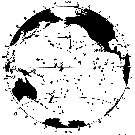 issued from : B. Frost & A. Fleminger in Bull. Scripps Inst. Oceanogr. Univ. California, San Diego, 1968, 12. [p.60, Chart 8, a]. issued from : B. Frost & A. Fleminger in Bull. Scripps Inst. Oceanogr. Univ. California, San Diego, 1968, 12. [p.60, Chart 8, a].
Occurrence of C. minor in samples examined; closed circles represent samples examined; open circles represent samples in which adults were found; bars through open circles represent samples from which specimens were removed for measurements. |
 issued from : B. Frost & A. Fleminger in Bull. Scripps Inst. Oceanogr. Univ. California, San Diego, 1968, 12. [p.61, Chart 8, b]. issued from : B. Frost & A. Fleminger in Bull. Scripps Inst. Oceanogr. Univ. California, San Diego, 1968, 12. [p.61, Chart 8, b].
Occurrence of C. minor in samples examined; closed circles represent samples examined; open circles represent samples in which adults were found; bars through open circles represent samples from which specimens were removed for measurements. |
 issued from : A. Cornils, B. Niehoff, C. Richter, T. Al-Najjar & B. Schnack-Schiel in J. Plankton Res., 2007, 29 (1). [p.60, Figs.1, 2]. issued from : A. Cornils, B. Niehoff, C. Richter, T. Al-Najjar & B. Schnack-Schiel in J. Plankton Res., 2007, 29 (1). [p.60, Figs.1, 2].
Above: Annual cycle of sea surface temperature and depth -integrated (0-100 m) chlorophyll a (mg/m2)
Below: Relative frequency (%) of the clausocalanid females over the investigation period (March 2002 to December 2003) in the northern Gulf of Aqaba (29°27'87 N, 34°57' 87 E; depth 300 m) for Clausocalanus minor, C. farrani, C. furcatus and Ctenocalanus vanus.
Nota: Collected by vertical hauls from 100 m depth to the surface. Sampling performed between 9 a.m. and 3 p.m. on a monthly basis. |
 Issued from : C.B. Miller in Biological Oceanography, Blackwell Publishing, 2005. [p.363, Fig. 16.16 (a)]. After Dessier & Donguy, 1987. Issued from : C.B. Miller in Biological Oceanography, Blackwell Publishing, 2005. [p.363, Fig. 16.16 (a)]. After Dessier & Donguy, 1987.
Time series of abundance estimates for Clausocalanus spp. (mainly C. minor, C. farrani, C. jobei) species sampled along the Pacific equator from passenger liner on a regular schedule.
Miller underlines that serial abundance for this species from the equator to 0°-2°N shows strong seasonality and dramatic reduction during the 1982-1983 El Niño (with a a sharp reduction of nitrate). A long list of other species also nearly vanished in that event. At least the stocks of hebivorous species rebounded immediately in 1984 (see E. rimana, a predator). |
| | | | Loc: | | | ? Angola (Baia Farta), South Africa, E Medit. (Lebanon Basin); Red Sea (G. of Aqaba), Gulf of Oman, Arabian Gulf, Kuwait, Somalia, Indian, Indonesia-Malaysia, Bintulu coast, SW Celebes, China Seas (East China Sea, South China Sea), Taiwan Strait, Taiwan (SW, E, W, NW, N, Mienhua Canyon), Japan (Tokyo Bay, Honshu: Suruga Bay), Hawaii, Australia ( Moreton Bay, Shark Bay, G. of Carpentaria), Tasman Sea, New Zealand, Pacif. (equatorial, tropical), California | | | | N: | 39 ? | | | | Lg.: | | | (29) F: 0,94; (30) F: 1,26-1,08; M: 1,04-0,79; ? (530) F: 1; ? (795) F: 0,96; (937) F: 1,17-1,25; M: 0,92-0,93; (1085) F: 1,1-1,3; M: 0,8-1; (1085) F: 1,1-1,3; M: 0,8-1,0; {F: 0,94-1,30; M: 0,79-1,04}
The mean female size is 1.157 mm (n = 7; SD = 0.1266), and the mean male size is 0.913 mm (n = 6; SD = 0.1019). The size ratio (male : female) is 0.77 (n = 3; SD = 0.0160). | | | | Rem.: | offshore. Depth: 0-600 m at Station N-1 (SW Bôsö, E middle Japan) from Furuhashi (1966 a).
For Frost & Fleminger (1968, p.62) females of C. minor differ from paululus in body length and in the form and spacing of basipodite 2 spiniform processes 2 and 3 of P3. males of C. minor are distinguished from farrani by the length ratio of A1 fused segments 20-21 to segment 22 and usually by the segmentation and appearance of the right P5. C. minor and jobei differ in the armature of the left P5 5th segment, the segmentation and appearance of the right P5, and the ratio of the length of the left 2nd segment of P5 to the width of urosomal segment 2. C. minor is distinguished from paululus by body length, the urosomal segment 2/3rd segment of P5 length ratios, and the form of the basipodite segment 2 spiniform processes 2 and 3 of P3.
After Cornils & al. (2007, p.66) the species differs from Clausocalanus arcuicornis by a protuberance beneath the genital pores (not found in C. arcuicornis), the seminal receptacles have a different shape, and a second anterior dorsal lobe is present.
For Greenwood (1977, p.54) the southward spread of this species along the east coast of Australia parallels that along east Africa and suggests transport of tropical water southward during the cooler months of the year.
According to Uysal & Shmeleva (2012, p. 918) this species is mentioned for the first time in the Eastern Mediterranean Sea (N Levantin Basin). | | | Last update : 15/09/2020 | |
|
|
 Any use of this site for a publication will be mentioned with the following reference : Any use of this site for a publication will be mentioned with the following reference :
Razouls C., Desreumaux N., Kouwenberg J. and de Bovée F., 2005-2025. - Biodiversity of Marine Planktonic Copepods (morphology, geographical distribution and biological data). Sorbonne University, CNRS. Available at http://copepodes.obs-banyuls.fr/en [Accessed December 17, 2025] © copyright 2005-2025 Sorbonne University, CNRS
|
|
 |
 |





















